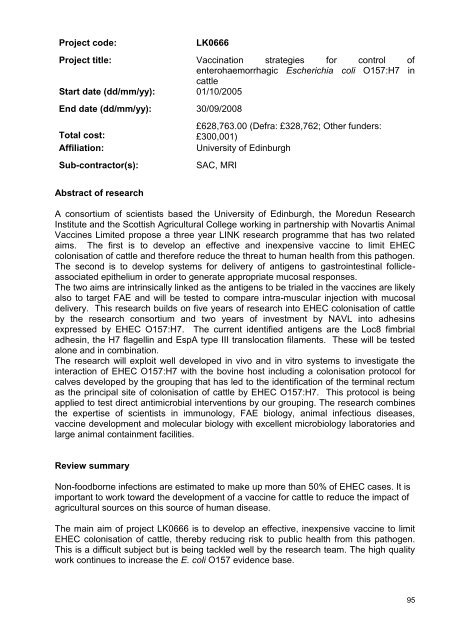Review of the Food-borne Zoonoses Research ... - ARCHIVE: Defra
Review of the Food-borne Zoonoses Research ... - ARCHIVE: Defra
Review of the Food-borne Zoonoses Research ... - ARCHIVE: Defra
You also want an ePaper? Increase the reach of your titles
YUMPU automatically turns print PDFs into web optimized ePapers that Google loves.
Project code: LK0666<br />
Project title: Vaccination strategies for control <strong>of</strong><br />
enterohaemorrhagic Escherichia coli O157:H7 in<br />
cattle<br />
Start date (dd/mm/yy): 01/10/2005<br />
End date (dd/mm/yy): 30/09/2008<br />
Total cost:<br />
£628,763.00 (<strong>Defra</strong>: £328,762; O<strong>the</strong>r funders:<br />
£300,001)<br />
Affiliation: University <strong>of</strong> Edinburgh<br />
Sub-contractor(s): SAC, MRI<br />
Abstract <strong>of</strong> research<br />
A consortium <strong>of</strong> scientists based <strong>the</strong> University <strong>of</strong> Edinburgh, <strong>the</strong> Moredun <strong>Research</strong><br />
Institute and <strong>the</strong> Scottish Agricultural College working in partnership with Novartis Animal<br />
Vaccines Limited propose a three year LINK research programme that has two related<br />
aims. The first is to develop an effective and inexpensive vaccine to limit EHEC<br />
colonisation <strong>of</strong> cattle and <strong>the</strong>refore reduce <strong>the</strong> threat to human health from this pathogen.<br />
The second is to develop systems for delivery <strong>of</strong> antigens to gastrointestinal follicleassociated<br />
epi<strong>the</strong>lium in order to generate appropriate mucosal responses.<br />
The two aims are intrinsically linked as <strong>the</strong> antigens to be trialed in <strong>the</strong> vaccines are likely<br />
also to target FAE and will be tested to compare intra-muscular injection with mucosal<br />
delivery. This research builds on five years <strong>of</strong> research into EHEC colonisation <strong>of</strong> cattle<br />
by <strong>the</strong> research consortium and two years <strong>of</strong> investment by NAVL into adhesins<br />
expressed by EHEC O157:H7. The current identified antigens are <strong>the</strong> Loc8 fimbrial<br />
adhesin, <strong>the</strong> H7 flagellin and EspA type III translocation filaments. These will be tested<br />
alone and in combination.<br />
The research will exploit well developed in vivo and in vitro systems to investigate <strong>the</strong><br />
interaction <strong>of</strong> EHEC O157:H7 with <strong>the</strong> bovine host including a colonisation protocol for<br />
calves developed by <strong>the</strong> grouping that has led to <strong>the</strong> identification <strong>of</strong> <strong>the</strong> terminal rectum<br />
as <strong>the</strong> principal site <strong>of</strong> colonisation <strong>of</strong> cattle by EHEC O157:H7. This protocol is being<br />
applied to test direct antimicrobial interventions by our grouping. The research combines<br />
<strong>the</strong> expertise <strong>of</strong> scientists in immunology, FAE biology, animal infectious diseases,<br />
vaccine development and molecular biology with excellent microbiology laboratories and<br />
large animal containment facilities.<br />
<strong>Review</strong> summary<br />
Non-food<strong>borne</strong> infections are estimated to make up more than 50% <strong>of</strong> EHEC cases. It is<br />
important to work toward <strong>the</strong> development <strong>of</strong> a vaccine for cattle to reduce <strong>the</strong> impact <strong>of</strong><br />
agricultural sources on this source <strong>of</strong> human disease.<br />
The main aim <strong>of</strong> project LK0666 is to develop an effective, inexpensive vaccine to limit<br />
EHEC colonisation <strong>of</strong> cattle, <strong>the</strong>reby reducing risk to public health from this pathogen.<br />
This is a difficult subject but is being tackled well by <strong>the</strong> research team. The high quality<br />
work continues to increase <strong>the</strong> E. coli O157 evidence base.<br />
95

















